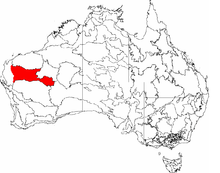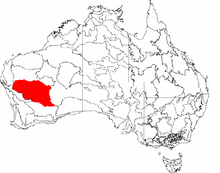Western Australian Mulga shrublands

The IBRA regions, with Gascoyne in red

The IBRA regions, with Murchison in red
The Western Australian Mulga shrublands is a large dry World Wildlife Fund ecoregion of inland Western Australia.[1]
Location and description
This is a hot, dry area with little rainfall.
The region consists of the Gascoyne, and Murchison bioregions of the Interim Biogeographic Regionalisation for Australia (IBRA).[2][3]
Flora and fauna
The predominant vegetation is mulga trees, a type of acacia adapted to the hot, dry climate by means of long tap roots. In some areas the mulga trees are surrounded by Eriachne grassland.
Wildlife of the region includes birds such as emus, Australian bustards and honeyeaters.
Most of the area is uninhabited but there is some mining activity and some sheep grazing, both of which cause damage to native habitats.
References
- ↑ "Western Australian Mulga shrublands". Terrestrial Ecoregions. World Wildlife Fund.
- ↑ Environment Australia. "Revision of the Interim Biogeographic Regionalisation for Australia (IBRA) and Development of Version 5.1 - Summary Report". Department of the Environment and Water Resources, Australian Government. Archived from the original on 2006-09-05. Retrieved 2007-01-31.
- ↑ IBRA Version 6.1 data
This article is issued from Wikipedia - version of the 1/30/2016. The text is available under the Creative Commons Attribution/Share Alike but additional terms may apply for the media files.